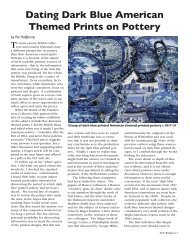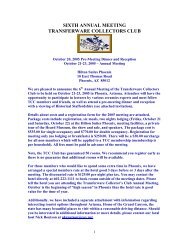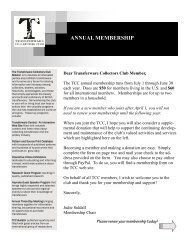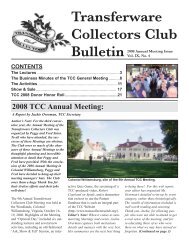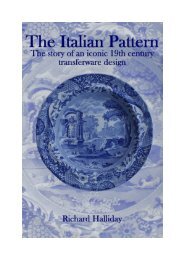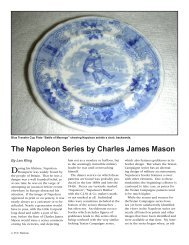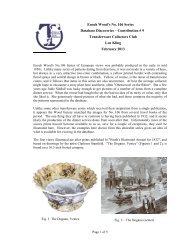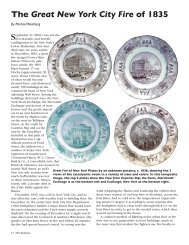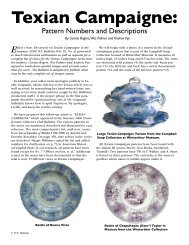download the publication - Transferware Collectors Club
download the publication - Transferware Collectors Club
download the publication - Transferware Collectors Club
Create successful ePaper yourself
Turn your PDF publications into a flip-book with our unique Google optimized e-Paper software.
over a Cornfield’ to see how mood and interpretive depth can be achieved.<br />
Van Gogh is, of course, unique and very few would be unable to recognise<br />
at least his later works of art. Artists working in pastels or water colour<br />
have to rely on tonal depth mixing or blending of colours , but, even here,<br />
how <strong>the</strong>y achieve <strong>the</strong>ir results is <strong>the</strong>ir style. No-one utilises pastels better<br />
than Edward Degas—his ballet dancers are unmistakably his as would be<br />
his handwriting. There is also to be taken into consideration <strong>the</strong> time and<br />
age when such work is being executed; for example religious and triptych<br />
work would never in style be attributed to <strong>the</strong> 19 th , 20 th or 21 st centuries in<br />
<strong>the</strong> same way that <strong>the</strong> Cubism of Braque and Picasso or <strong>the</strong> earlier work of<br />
Cezanne could never be attributed to <strong>the</strong> 16 th , 17 th or 18 th centuries.<br />
Style changes with <strong>the</strong> times and contemporary events for example<br />
photography meant that Art was never going to be of <strong>the</strong> same format<br />
again, except for <strong>the</strong> very rare example or perhaps <strong>the</strong> Pre Raphaelites who<br />
sought to retreat by way of escape into <strong>the</strong> centuries of rural romanticism<br />
and chivalry. So how <strong>the</strong>n do we define <strong>the</strong> style in printing and <strong>the</strong> style<br />
of an individual engraver? With great difficulty!<br />
Today engraving is mechanical and uniform. We are not engravers and<br />
certainly not 18 th century engravers, so all we are able to address is <strong>the</strong><br />
visual impact of <strong>the</strong> prints as found on pottery. We have some knowledge<br />
of style in painting and how it develops in <strong>the</strong> individual artist as<br />
seemingly it did with Rothwell. He adjusted his engravings both for<br />
printing on pottery and with <strong>the</strong> need for <strong>the</strong> style change required with<br />
Chinoiserie, commemorative or idyllic romantic type images. We have<br />
endeavoured to assess his work as best we can but do please bear in mind<br />
we do not set ourselves up as expert engravers.<br />
In transferware pottery <strong>the</strong> fashionable and well-to-do of <strong>the</strong> 18 th century<br />
were desirous of <strong>the</strong> views in <strong>the</strong> Chinoiserie style, oriental and <strong>the</strong><br />
appealing and attractive romantic and idealistic view of rural life and<br />
landscape on pottery. Important contemporaneous historic events including<br />
<strong>the</strong> lives of <strong>the</strong> Royal family were also of intense patriotic interest and<br />
Thomas Rothwell provided all of <strong>the</strong> above.<br />
We endeavour to illustrate with examples some of <strong>the</strong> patterns that not<br />
only relate to each o<strong>the</strong>r in date but also how <strong>the</strong> engravings were<br />
achieved. It seems to us that to show small groups of patterns and borders<br />
linked by <strong>the</strong>ir style is an effective way of doing this and so we will begin<br />
with some of <strong>the</strong> earliest Rothwell must have executed on his arrival at<br />
Swansea.<br />
21



